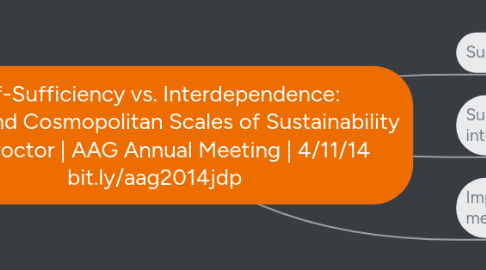
1. Sustainability in time and space
1.1. Time
1.1.1. Equilibrium?
1.1.2. Resilience?
1.2. Space
1.2.1. The curse of TGAL
1.2.2. My point of departure
2. Sustainability as self-sufficiency vs. interdependence
2.1. Self-sufficiency
2.1.1. Goal: Long-term efficiency in a bounded system
2.1.2. Example: Triple net zero design for Expo 2017, Kazakhstan
2.1.3. Spatial assumption: Incrementalism
2.1.4. Limitation: Insularity
2.2. Interdependence
2.2.1. Goal: Spatial equity across a network of dependencies
2.2.2. Example: WCED 1987
2.2.2.1. "Interdependence is not simply a local phenomenon. Rapid growth in production has extended it to the international plane, with both physical and economic manifestations.…Even the narrow notion of physical sustainability implies a concern for social equity between generations, a concern that must logically be extended to equity within each generation."
2.2.3. Example: Core-periphery states
2.2.4. Contemporary basis: Cosmopolitanism
2.2.4.1. Cosmopolitan Vision (Ulrich Beck, 2006): "We can provisionally distinguish five interconnected constitutive principles of the cosmopolitan outlook: (a) The principle of the experience of crisis in world society… (b) The principle of recognition of cosmopolitan differences… (c) The principle of cosmopolitan empathy… (d) The principle of the impossibility of living in a world society without borders… (e) The mélange principle…that local, national, ethnic, religious and cosmopolitan cultures and traditions interpenetrate… cosmopolitanism without provincialism is empty, provincialism without cosmopolitanism is blind" (p. 7)
2.2.4.2. Sense of Place & Sense of Planet (Ursula Heise, 2008): "[Eco-cosmopolitanism] confronts more local attachments in the case of environmentalism in the United States which have been articulated by means of such concepts as 'dwelling,' 'reinhabitation,' 'bioregionalism,' an 'erotics of place,' or a 'land ethic' (10)
2.2.4.3. From multiculturalism to multinaturalism (Latour 2011): "By reusing this venerable word [cosmopolitics] from the Stoics, [Isabelle Stengers] does not mean that we should be attuned only to the many qualities of multiculturalism and internationalism, but to the many worries of multinaturalism as well" (p. 9)
3. Implications: Practicing and measuring sustainability
3.1. Big questions
3.1.1. What sorts of systems (short of the entire earth system) are physically, and not just administratively, bounded?
3.1.2. In what ways does sustainability-as-self-sufficiency provide political cover to effectively greenwash institutions?
3.1.3. What sorts of metrics ought to be applied to assess sustainability as interdependence?
3.1.4. Indeed, what sorts of interdependencies ought to be sustained?
3.2. One practical question: College sustainability
3.2.1. AASHE
3.2.1.1. STARS & campuscentrism
3.2.2. Possibilities: GRI?
3.2.2.1. GRI & boundaries
